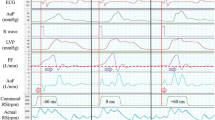Summary
As the clinical application of LVADs has increased, attempts have been made to develop smaller, less expensive, more durable and efficient implantable devices using rotary blood pumps. Since chronic circulatory support with implantable continuous-flow LVADs will be established in the near future, we need to determine the flow characteristics through an implantable continuous-flow LVAD. This study describes the flow characteristics through an implantable centrifugal blood pump as a left ventricular assist device (LVAD) to obtain a simple non-invasive algorithm to control its assist flow rate adequately. A prototype of the completely seal-less and pivot bearing-supported centrifugal blood pump was implanted into two calves, bypassing from the left ventricle to the descending aorta. Device motor speed, voltage, current, flow rate, and aortic blood pressure were monitored continuously. The flow patterns revealed forward flow in ventricular systole and backward flow in diastole. As the pump speed increased, an end-diastolic notch became evident in the flow profile. Although the flow rate (Q [1/min]) and rotational speed (R [rpm]) had a linear correlation (Q=0.0042R−5.159;r=0.96), this linearity was altered after the end-diastolic notch was evident. The end-diastolic notch is considered to be a sign of the sucking phenomenon of the centrifugal pump. Also, although the consumed current (I [A]) and flow rate had a linear correlation (I=0.212Q+0.29;r=0.97), this linearity also changed after the end-diastolic notch was evident. Based upon the above findings, we propose a simple algorithm to maintain submaximal flow without inducing sucking. To maintain the submaximal flow rate without measuring flow rate, the sucking point is determined by monitoring consumed current according to gradual increases in voltage.
Similar content being viewed by others
References
McCarthy PM (1995) Heart Mate implantable left ventricular assist device: Bridge to transplantation and future applications. Ann Thorac Surg 59:S46–51
Kormos RL, Gasior TK, Kawai A, Pham SM, Murali S, Hattler BG, Griffith BP (1996) Transplant candidate’s clinical status rather than right ventricular function defines need for univentricular versus biventricular support. J Thorac Cardiovasc Surg 111:773–783
Nakatani T, Sasako Y, Kumon K, Nagata S, Kosakai Y, Isobe F, Nakano K, Kobayashi J, Eishi K, Takano H, Kito Y, Kawashima Y (1995) Long-term circulatory support to promote recovery from profound heart failure. ASAIO J 41:M526–530
Frazier OH, Benedict CR, Radovancevic B, Bick RJ, Capek P, Springer WE, Macris MP, Delgado R, Buja LM (1996) Improved left ventricular function after chronic left ventricular unloading. Am Thorac Surg 62:675–682
Nosé Y (1996) FDA approval of clinical studies on left ventricular assist system for its therapeutic application. Artif Organs 20:283
Ohara Y, Makinouchi K, Glueck J, Sutherland B, Shimono T, Naito K, Tasai K, Orime Y, Takatani S, Nosé Y (1994) Development and evaluation of antithrombogenic centrifugal pump; The Baylor C-Gyro pump eccentric inlet port model. Artif Organs 18:673–679
Golding LAR, Smith WA, Bodmann DR (1996) The Cleveland Clinic rotodynamic pump program. Artif Organs 20:481–484
Taenaka Y, Wakisaka Y, Masuzawa T, Tatsumi E, Toda K, Miyazaki K, Eya K, Baba Y, Nakatani T, Ohno T, Nishimura T, Takano H (1996) Development of a centrifugal pump with improved antithrombogenicity and hemolytic property for chronic circulatory support. Artif Organs 20:491–496
Nishimura K, Park CH, Akamatsu T, Yamada T, Ban T (1996) Development of a magnetically suspended centrifugal pump as a cardiac assist device for long-term application. ASAIO J 42:68–71
Bearnson GB, Malsen EH, Olsen DB, Allaire PE, Khanwilkar PS, Long JW, Kim HC (1996) Development of a prototype magnetically suspended rotor ventricular assist device. ASAIO J 42:275–281
Kawahito K, Benkowski R, Otsubo S, Rosenbaum B, Moreland R, Noon GP, Nosé Y, DeBakey ME (1996) Ex vivo evaluation of the NASA/DeBakey axial flow ventricular assist device. ASAIO J 42:M754–757
Konishi H, Antaki JF, Litwak P, Kameneva M, Yamazaki k, Mache M, Kerrigan JP, Mandarino WA, Butler KC, Borovetz HS, Kormos RL (1996) Long-term animal survival with an implantable axial flow pump as a left ventricular assist device. Artif Organs 20:124–127
Kaplon RJ, Oz MC, Kwiatkowski PA, Levin HR, Shah AS, Jarvic RK, Rose EA (1996) Miniature axial flow pump for ventricular assistance in children and small adults. J Thorac Cardiovasc Surg 111:13–18
Snyder AJ, Rosenberg G, Pierce WS (1992) Noninvasive control of cardiac output for alternatively ejecting dual-pusherplate pumps. Artif Organs 16:189–194
Schima H, Trubel W, Moritz A, Wieselthaler G, Stöhr HG, Thoma H, Losert U, Wolner E (1992) Noninvasive monitoring of rotary blood pumps: Necessity, possibility, and limitations. Artif Organs 16:195–202
Ohara Y, Sakuma I, Makinouchi K, Damm G, Glueck J, Mizuguchi K, Naito K, Tasai K, Orime Y, Takatani S, Noon GP, Nosé Y (1993) Baylor Gyro Pump: A completely seal-less centrifugal pump aiming for long-term circulatory support. Artif Organs 17:599–604
Ohara Y, Makinouchi K, Orime Y, Damm G, Glueck J, Mizuguchi K, Naito K, Tasai K, Takatani S, Noon GP, Nosé Y (1994) An ultimate, compact, seal-less centrifugal ventricular assist device: Baylor C-Gyro Pump. Artif Organs 18:17–24
Nakazawa T, Makinouchi K, Ohara Y, Ohtsubo S, Kawahito K, Tasai K, Shimono T, Benkowski R, Damm G, Takami Y, Glueck J, Savage A, Takatani S, Noon GP, Nosé Y (1996) Development of a pivot bearing-supported seal-less centrifugal pump for ventricular assist device. Artif Organs 20:485–490
Schima H, Schmallegger H, Huber L, Birgmann I, Rindl C, Schmidt C, Roschal K, Wieselthaler G, Trubel W, Lower U, Wolner E (1995) An implantable seal-less centrifugal pump with integrated double-disk motor. Artif Organs 19:639–643
Konishi H, Antaki JF, Amin DV, Boston JR, Kerrigan JP, Mandarino WA, Litwak P, Yamazaki K, Mache M, Butler KC, Borovetz HS, Kormos RL (1996) Controller for an axial flow blood pump. Artif Organs 20:618–620
Author information
Authors and Affiliations
Rights and permissions
About this article
Cite this article
Takami, Y., Otsuka, G., Mueller, J. et al. Flow characteristics and required control algorithm of an implantable centrifugal left ventricular assist device. Heart Vessels 12, 92–97 (1997). https://doi.org/10.1007/BF02820872
Received:
Accepted:
Issue Date:
DOI: https://doi.org/10.1007/BF02820872




